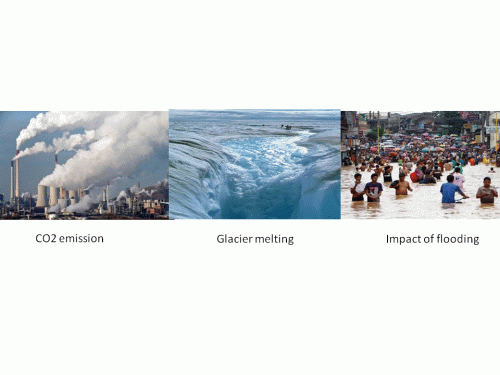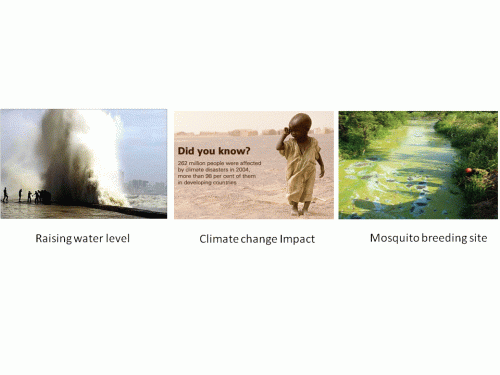As a molecular biologist, my mind is frequently focused highly at the microscopic level. I rarely consider the impact of large-scale environmental or cultural events on the very small molecules or microorganisms which coexist along side us. Since reading Influence of environmental factors on the presence of Vibrio cholerae in the marine environment: a climate link, I now have an appreciation for the link between infectious diseases and the ecosystem; that is, how the visible affects the invisible or will eventually affect the visible.
The interaction between the weather and infectious disease status is an important area of research. Many examples throughout history show how weather pattern changes and natural disasters lead to catastrophic disease outbreaks. One recent example is the current outbreak of chloera in Haiti which occurred following the earthquake of 2010 (Kelvin AA JIDC 2011). The earthquake, which devastated the country’s already weak water sanitization system, created a habitable environment for the colonization of the Cholera bacterium and facilitated the spread of the disease. Perhaps my favorite article which reviews the interaction between climate change/weather and infectious disease outbreaks is an article by V. Sedas. In this article, Sedas reviews how environmental factors have significant influence on the outbreak potential and pathogenesis of V. cholerae and other disease causing agents (Seda VT JIDC 2007). As the fecal-oral transmission route of V. cholera relies heavily on the ecology of the native water supply, seasonal water cycles have been shown to affect the emergence and re-emergence of V. cholerae, thereby affecting the health of local populations (Seda VT JIDC 2007). This article I highly recommend reading.
In this JIDC Postcard, Yadav Prasad Joshi reflects on how anthropocentric climate change is influencing health, lifestyle and ecosystems globally. Yadav Prasad Joshi is a PhD student from Nepal and his post provides an invaluable perspective on climate change.
Alyson
Climate Change, Perspectives from Nepal
Have you ever thought about what might be considered the worst event to affect this planet? From wars to terrorism to nuclear emissions, the list is long, but few people would point out the events of climate change. Tsunamis, floods, heat waves, glacial melting and threats to biodiversity are all disasters that affect not only the people in the regions experiencing them, but everyone worldwide.
Weather and climate play a significant role in people’s health. Changes in climate affect average weather conditions. Warmer average temperatures will likely lead to hotter days and more frequent and longer heat waves, which could increase the number of heat related illnesses and deaths. Increases in the frequency or severity of extreme weather events such as storms could accelerate the risk of dangerous flooding, high winds, and other direct threats to people and property. Warmer temperatures could increase the concentrations of unhealthy air and water pollutants. Changes in temperature, precipitation patterns, and extreme events could enhance the spread of some diseases.
Global climate change has become one of the most visible environmental concerns (Bioterrorism) of the 21st century. Climate change has brought about severe and possibly permanent alterations to our planet’s geological, biological and ecological systems. The Intergovernmental Panel on Climate Change (IPCC) now contends that “there is new and stronger evidence that most of the warming observed over the last 50 years is attributable to human activities”.1 These changes have led to the emergence of large-scale environmental hazards to human health, such as ozone depletion, the greenhouse effect, acid rain, loss of biodiversity, stresses to food-producing systems and the global spread of infectious diseases.1,2 The World Health Organization(WHO) estimates that 160,000 deaths, since 1950, are directly attributable to climate change.3
During the last 100 years, human activities related to the burning of fossil fuels, deforestation and agriculture have led to a 35% increase in CO2 levels in the atmosphere, causing increased trapping of heat and warming of the earth’s atmosphere. Eleven of the last 12 years (1995-2006) rank among the 12 warmest years in the instrumental record of global surface temperature. The IPCC reports that the global average sea level rose at an average rate of 1.8 mm per year from 1961 to 2003. The total rise in the sea level during the 20th century was estimated to be 0.17 metres and projected increase in temperature range is 1.8oC to 4.0oC by the end of this century .1,4
These IPCC reports changes point to the drastic effects that climate change could have onlife in tropical counties and islands such as Vietnam, Mongolia, Laos, Philippines, Papua New Guinea, Nauru, Micronesia, and Tonga among others. Some of these Islands are only two to three metres above sea level and by viewing this trend of climate change, it is very difficult to predict the future of these countries. The most common observed phenomena are increasing sea level, acidification, alteration in weather conditions, droughts, cyclones, extreme ENSO (El Nino Southern Oscillation) and EI Nino effects, etc.
Climate change has dramatically and negatively affected human health in the form of increased burden of diseases of all types, in particular vector-borne illnesses such as dengue and malaria. Changes in climate increase the temperature, which in turn accelerates the multiplication of vectors by breeding, causes droughts which kill crops in some areas or floods which cause cholera in others, thus contributing either directly or indirectly to other diseases such as malnutrition and water-borne, air-borne, and food-borne diseases.
Climate change associated with increasingly frequent and severe weather events and causes extensive infrastructure damage, economic slowdown, and interruptions of medical and psychiatric care, all which are likely to affect mental health in several ways. These events, and the lifestyle changes that can result, are associated with increased mental health burdens.5
Basically, there are two ways to contend with climate change: adaptation and mitigation. The former is as a short-term solution that addresses only how to protect ourselves from adverse condition, whereas the latter is a long-term process. Therefore, both should run simultaneously. Research area in the sectors of climate change should be highly prioritized and awareness program should be initiated from local levels. For all these activities, governments of all nations should responsible, and develop and implement proper national action plans for climate change.
Who is responsible for these overall hazardous conditions caused by climate change? The answer is human beings. Now the time has come to protect our lovely earth and to think about what we are leaving for our future generations. It is not the time to look for blame for problems such as increasing CO2 concentrations, clear-cutting of the forests and so on. t This is the time for all nations and human beings to unite with integrity to save the earth and protect the earth for our progeny.
It is my hope that every human will commit to protecting our planet from changing climate and its disastrous effects on human health.
More opinions in this context are highly welcomed. For further information, please contact the author at yadavjoshi@gmail.com
References
- McMichael AJ (2003) Global Climate Change and Health: An Old Story Writ Large. A. J. McMichael et al. editors. World Health Organization Geneva. 1-17.
- Sahney, S, Benton MJ, Ferry PA (2010) Links between the global taxonomic diversity and expansion of vertebrates on the land, Biology letters 6: 544-547. Available at: http://rsbl.royalsocietypublishing.org/content/6/4/544.full.
- McMichael AJ, Woodruff R, Hales S (2006) Climate change and human health: Present and future risks. Lancet 367: 859-869.
4. Climate change and health in Cambodia (2008) A vulnerability and adaptation assessment, WHO/MoH.
5. Roth P ( 2010) Climate change and health: mental health effects, News and views on climate, public health and environment. Available at: http://climatechangehealth.com/tag/ptsd. Accessed on: 1 March 2010.
 Mr. Yadav Prasad Joshi is Nepalese and graduated from Tribhuvan University, Nepal, in Zoology and Psychology. He is extremely interested in infectious diseases and climate change. He joined the JIDC in 2007 as a Reviewer and Editorial Board member in 2012. Mr. Yadav Prasad Joshi has more than 10 years’ teaching experience in biological science to college, university, and medical students. He participates equally in research activities, seminars, and book writing. He has done research in tuberculosis, malaria, and many other public health issues.
Mr. Yadav Prasad Joshi is Nepalese and graduated from Tribhuvan University, Nepal, in Zoology and Psychology. He is extremely interested in infectious diseases and climate change. He joined the JIDC in 2007 as a Reviewer and Editorial Board member in 2012. Mr. Yadav Prasad Joshi has more than 10 years’ teaching experience in biological science to college, university, and medical students. He participates equally in research activities, seminars, and book writing. He has done research in tuberculosis, malaria, and many other public health issues.
Currently, he is a PhD student at Sungkyunkwan University, South Korea, in the department of Social and Preventative Medicine. His research topic is climate change and health.












